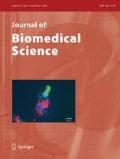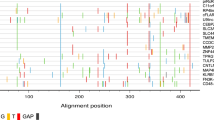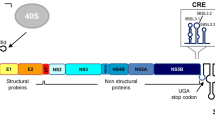Abstract
The Rev axis of HIV is one of two key autoregulatory pathways required for viral replication and pathogenesis. The viral Rev protein interacts with its RNA target sequence, the RRE, to overcome the inhibitory effects of constitutive repressor sequences and promote nucleocytoplasmic transport and expression of viral RNAs. The Rev axis is the subject of intense scrutiny not only because it plays a central role in the viral life cycle, but also because it offers a window onto the workings of key mechanisms of posttranscriptional regulation, including splicing, polyadenylation, degradation, transport, and translation. Recent reports have conclusively demonstrated a central role for transport in the Rev mechanism and have identified cellular factors that are good candidates for mediating the transport phenomena. Other potentially involved cellular factors are being investigated. Much of the apparent heterogeneity in the observed effects of Rev may actually derive from heterogeneity in the constitutive repressor sequences rather than from heterogeneity in the mechanism of action of Rev per se.
Similar content being viewed by others
References
Ahmed YF, Hanly SM, Malim MH, Cullen BC, Green WC. Structure-function analyses of the HTLV-I Rex and RNA response elements: Insights into the mechanism of Rex and Rev action. Genes Dev 4:1014–1022;1990.
Arrigo SJ, Chen ISY. Rev is necessary for translation but not cytoplasmic accumulation of HIV-1 vif, vpr and env/vpu 2 RNAs. Genes Dev 5:808–819;1991.
Arrigo SJ, Heaphy S, Haines JK. In vivo binding of wild-type and mutant human immunodeficiency virus type 1 Rev proteins: Implications for function. J Virol 66:5569–5575;1992.
Arrigo SJ, Weitsman S, Rosenblatt JD, Chen ISY. Analysis of rev gene function on human immunodeficiency virus type 1 replication in lymphoid cells by using a quantitative polymerase chain reaction method. J Virol 63:4875–4881;1989.
Baker C. Personal communication.
Barksdale S, Baker CC. The human immunodeficiency virus type 1 Rev protein and the Rev-responsive element counteract the effect of an inhibitory 5′ splice site in a 3′ untranslated region. Mol Cell Biol 15:2962–2971;1995.
Bartel DP, Zapp ML, Green MR, Szostak JW. HIV-1 Rev regulation involves recognition of non-Watson-Crick base pairs in viral RNA. Cell 67:529–536;1991.
Benko DM, Robinson R, Solomin L, Mellini M, Felber BK, Pavlakis GN. Binding of transdominant mutant Rev protein of human immunodeficiency virus type 1 to the cis-acting Rev-responsive element does not affect the fate of viral mRNA. New Biologist 2:1111–1122;1990.
Berger J, Aepinus C, Dobrovnik M, Fleckenstein B, Hauber J, Bohnlein E. Mutational analysis of functional domains in the HIV-1 Rev trans-regulatory protein. Virology 183:630–635;1991.
Bogerd HP, Fridell RA, Madore S, Cullen BR. Identification of a novel cellular cofactor for the Rev/Rex class of retroviral regulatory proteins. Cell 82:485–494;1995.
Bohnlein S, Pirker FP, Hofer L, Zimmermann K, Bachmayer H, Bohnlein E, Hauber J. Transdominant repressors for human T-cell leukemia virus type 1 Rex and human immunodeficiency virus type 1 Ref function. J Virol 65:81–88;1991.
Bray M, Prasad S, Dubay JW, Hunter E, Jeang K-T, Rekosh D, Hammarskjold M-L. A small element from the Mason-Pfizer monkey virus genome makes human immunodeficiency virus type 1 expression and replication Rev-independent. Proc Natl Acad Sci USA 91:1256–1260;1994.
Brighty DW, Rosenberg M. A cis-acting repressive sequence that overlaps the Rev-responsive element of human immunodeficiency virus type 1 regulates nuclear retention of env mRNAs independently of known splice. Proc Natl Acad Sci USA 91:8314–8318;1994.
Campbell LH, Borg KT, Haines JK, Moon RT, Schoenberg DR, Arrigo SJ. Human immunodeficiency virus type 1 Rev is required in vivo for binding of poly(A)-binding protein to Rev-dependent RNAs. Virol 68:5433–5438;1994.
Chang DD, Sharp PA. Regulation by HIV Rev depends upon recognition of splice sites. Cell 59:789–795;1989.
Cochrane AW, Jones KS, Beidas S, Dillon PJ, Skalka AM, Rosen CA. Identification and characterization of intragenic sequences which repress human immunodeficiency virus structural gene expression. J Virol 65:5305–5313;1991.
Cook KS, Fisk GJ, Hauber J, Usman N, Daly TJ, Rusche JR. Characterization of HIV-1 Rev protein: Binding stoichiometry and minimal RNA substrate. Nucleic Acids Res 19:1577–1583;1991.
Cullen BR. Mechanism of action of regulatory proteins encoded by complex retroviruses. Microbiol Rev 56:375–394;1992.
Cullen BR. RNA-sequence-mediated gene regulation in HIV-1. Infect Agents Dis 3:68–76;1994.
D'Agostino DM, Felber BK, Harrison JE, Pavlakis GN. The Rev protein of human immunodeficiency virus type 1 promotes polysomal association and translation of gag/pol and vpu/env mRNAs. Mol Cell Biol 12:1375–1386;1992.
Daly TJ, Cook KS, Gray GS, Malone TE, Rusche JR. Specific binding of HIV-1 recombinant Rev protein to the Rev responsive element in vitro. Nature 342:816–819;1989.
Dayton ET, Konings DAM, Powell DM, Shapiro BA, Butini L, Maizel JV, Dayton AI. Extensive sequence-specific information throughout the CAR/RRE, the target sequence of the human immunodeficiency virus type 1 Rev protein. J Virol 66:1139–1151;1992.
Dayton ET, Powell DM, Dayton AI. Functional analysis of CAR. The target sequence for the Rev protein of HIV-1. Science 246:1625–1629;1989.
Dayton AI, Terwilliger EF, Potz J, Kowalski M, Sodroski JG, Haseltine WA. Cis-acting sequences responsive to the Rev gene product of the human immunodeficiency virus. J Acquir Immune Defic Syndr 1:441–452;1988.
Dreyfuss G, Matunis MJ, Pinol-Roma S, Burd CG. hnRNP proteins and the biogenesis of mRNA. Annu Rev Biochem 62:289–321;1993.
Emerman M, Vazeux R, Peden K. The Rev gene product of the human immunodeficiency virus affects envelope-specific RNA localization. Cell 57:1155–1165;1989.
Felber BK, Hadzopoulou-Cladaras M, Cladaras CT, Pavlakis GN. Rev protein of human immunodeficiency virus type 1 affects the stability and transport of the viral mRNA. Proc Natl Acad Sci USA 86:1495–1499;1989.
Fields S, Song O. A novel genetic system to detect protein-protein interactions. Nature 340:245–246;1989.
Fischer U, Huber J, Boelens WC, Mattaj IW, Luhrmann R. The HIV-1 Rev activation domain is a nuclear export signal that accesses an export pathway used by specific cellular RNAs. Cell 82:475–483;1995.
Fischer U, Meyer S, Teufel M, Heckel C, Luhrmann R, Rautman G. Evidence that HIV-1 Rev directly promotes the nuclear export of unspliced RNA. EMBO J 13:4105–4112;1994.
Fridell RA, Fischer U, Luhrmann R, Meyer BE, Meinkoth JL, Malim MH, Cullen BR. Amphibian TFIIIA proteins contain a sequence element functionally equivalent to the nuclear export signal of HIV-1 Rev. Proc Natl Acad Sci USA, in press.
Fridell RA, Partin KM, Carpenter S, Cullen BR. Identification of the activation domain of equine infectious anemia virus Rev. J Virol 67:7317–7323;1993.
Fritz CC, Zapp ML, Green MR. A human nucleoporin-like protein that specifically interacts with HIV Rev. Nature 376:530–533;1995.
Gait MJ, Karn J. RNA recognition by the human immunodeficiency virus Tat and Rev proteins. Trends Biochem Sci 18:255–259;1993.
Green MR. Molecular mechanisms of Tat and Rev. AIDS Res Rev 3:41–55;1993.
Guddat U, Bakken AH, Pieler T. Protein-mediated nuclear export of RNA: 5S rRNA containing small RNPs in Xenopus oocytes. Cell 60:619–628;1990.
Hammarskjold M-L, Li H, Rekosh D, Prasad S. Human immunodeficiency virus env expression becomes rev-independent if the env region is not defined as an intron. J Virol 68:951–958;1994.
Haseltine WA. Molecular biology of the human immunodeficiency virus type 1. FASEB J 5:2349–2360;1991.
Heaphy S, Dingwall C, Ernberg I, Gait MJ, Green SM, Karn J, Lowe AD, Singh M, Skinner MA. HIV-1 regulator of virion expression (Rev) protein binds to an RNA stem-loop structure located within the Rev response element region. Cell 60:685–693;1990.
Heaphy S, Finch JT, Gait MJ, Karn J, Singh M. Human immunodeficiency virus type 1 regulator of virion expression, Rev, forms nucleoprotein filaments after binding to a purine-rich ‘bubble’ located within the Rev-responsive region of viral mRNAs. Proc Natl Acad Sci USA 88:7366–7370;1991.
Holland SM, Ahmad N, Maitra RK, Wingfield P, Venkatesan S. Human immunodeficiency virus Rev protein: A target sequence in Revresponsive element RNA within the context of RNA secondary structure. J Virol 64:5966–5975;1990.
Hope TJ, Bond BL, McDonald D, Klein NP, Parslow TG. Effector domains of human immunodeficiency virus type 1 Rev and human T-cell leukemia virus type 1 Rex are functionally interchangeable and share an essential peptide motif. J Virol 65:6001–6007;1991.
Hope T, Pomerantz RJ. The human immunodeficiency virus type 1 Rev protein: A pivotal protein in the viral life cycle. Curr Top Microbiol Immunol 193:91–105;1995.
Huang X, Hope TJ, Bond BL, McDonald D, Grahl K. Minimal Rev-response element for type 1 human immunodeficiency virus. J Virol 65:2131–2134;1991.
Kalland K-H, Szilvay AM, Brokstad KA, Saetrevik W, Haukness G. The human immunodeficiency virus type 1 Rev protein shuttles between the cytoplasm and nuclear compartments. Mol Cell Biol 14:7436–7444;1994.
Katahira J, Ishizaki T, Sakai H, Adachi A, Yamamoto K, Shida H. Effects of translation initiation factor eIF-5A on the functioning of human T-cell leukemia virus type I Rex and human immunodeficiency virus Rev inhibitedtrans dominantly by a Rex mutant deficient in RNA binding. J Virol 69:3125–3133;1995.
Kjems J, Brown M, Chang DD, Sharp PA. Structural analysis of the interaction between the human immunodeficiency virus Rev protein and the Rev response element. Proc Natl Acad Sci USA 88:683–687;1991.
Kjems J, Frankel AD, Sharp PA. Specific regulation of mRNA splicing in vitro by a peptide from HIV-1 Rev. Cell 67:169–178;1991.
Le S-Y, Malim MH, Cullen BR, Maizel JV. A highly conserved RNA folding region coincident with the Rev element of primate immunodeficiency viruses. Nucleic Acids Res 18:1613–1623;1990.
Lu XB, Heimer J, Rekosh D, Hammarskjold ML. U1 small nuclear RNA plays a direct role in the formation of a Rev-regulated human immunodeficiency virus env mRNA that remains unspliced. Proc Natl Acad Sci USA 87:7598–7602;1990.
Madore SJ, Tiley LS, Malim MH, Cullen BR. Sequence requirements for Rev multimerization in vivo. Virology 202:186–194;1994.
Maldarelli F, Martin MA, Strebel K. Identification of posttranscriptionally active inhibitory sequences in human immunodeficiency virus type 1 RNA: Novel level of gene regulation. J Virol 65:5732–5743;1991.
Malim MH, Bohnlein S, Hauber J, Cullen BR. Functional dissection of the HIV-1 Ref transactivator: Derivation of a trans-dominant repressor of Rev function. Cell 58:205–214;1989.
Malim MH, Cullen BR. HIV-1 structural gene expression requires the binding of multiple Rev monomers to the viral RRE: Implications for HIV-1 latency. Cell 65:241–248;1991.
Malim MH, Hauber J, Le SY, Maizel JV, Cullen BR. The HIV-1 Rev trans-activator acts through a structured target sequence to activate nuclear export of unspliced viral mRNA. Nature 338:254–257;1989.
Malim M, McCarn DF, Tiley LS, Cullen BR. Mutational definition of the human immunodeficiency virus type 1 Rev activation domain. J Virol 65:4248–4254;1991.
Malim MH, Tiley LS, McCarn DF, Rusche JR, Hauber J, Cullen BR. HIV-1 structural gene expression requires binding of the Rev transactivator to its RNA target sequence. Cell 60:675–683;1990.
Mancuso VA, Hope TJ, Zhu L, Derse D, Phillips T, Parslow TG. Posttranscriptional effector domains in the Rev proteins of feline immunodeficiency virus and equine infectious anemia virus. J Virol 68:1998–2001;1994.
Mann DA, Mikaelian I, Zemmel RW, Green SM, Lowe AD, Kimura T, Singh M, Butler PJ, Gait MJ, Karn J. A molecular rheostat. Co-operative Rev binding to stem I of the Revresponse element modulates human immunodeficiency virus type-1 late gene expression. J Mol Biol 241:193–207;1994.
Mermer B, Felber BK, Campbell M, Pavlakis GM. Identification of trans-dominant HIV-1 Rev protein mutants by direct transfer of bacterially produced proteins into human cells. Nucleic Acids Res 18:2037–2044;1990.
Meyer BE, Malim MH. The HIV-1 Rev transactivator shuttles between the nucleus and the cytoplasm. Genes Dev 8:1538–1547;1994.
Nasioulas G, Zolotukhin AS, Tabernero C, Solomin L, Cunningham CP, Pavlakis GN, Felber BK. Elements distinct from human immunodeficiency virus type 1 splice sites are responsible for the Rev dependence of env mRNA. J Virol 68:2986–2993;1994.
Olsen HS, Cochrane AW, Dillon PJ, Nalin CM, Rosen CA. Interaction of the human immunodeficiency virus type 1 Rev protein with a structured region in env mRNA is dependent on multimer formation mediated through a basic stretch of amino acids. Genes Dev 4:1357–1364;1990.
Olsen HS, Cochrane AW, Rosen C. Interaction of cellular factors with intragenic cis-acting repressive sequences within the HIV genome. Virology 191:709–715;1992.
Poeschla E, Wong-Staal F. Molecular biology of HIV: Challenges for the second decade. AIDS Res Hum Retroviruses 10:111–112;1994.
Powell DM, Zhang MJ, Konings DAM, Wingfield PT, Stahl SJ, Dayton ET, Dayton AI. Sequence specificity in the higher-order interaction of the Rev protein of HIV-1 with its target sequence, the RRE. J Acquir Immune Defic Syndr Hum Retrovirol 10:317–323;1995.
Reddy TR, Kraus G, Suhasini M, Leavitt MC, Wong-Staal F: Identification and mapping of inhibitory sequences in the human immunodeficiency virus type 2vif gene. J Virol 69:5167–5170;1995.
Rosen CA, Pavlakis GN. Tat and Rev: Positive regulators of HIV gene expression. AIDS 4:499–450;1990.
Rosen CA, Terwilliger E, Dayton AI, Sodroski JG. Intragenic cis-acting art gene-responsive sequence of the human immunodeficiency virus. Proc Natl Acad Sci USA 85:2071–2075;1988.
Ruhl M, Himmelspach M, Bahr GM, Hammerschmid F, Jakshe H, Wolff B, Aschauer H, Farrington GK, Probst H, Bevec D, Hauber J. Eukaryotic initiation factor 5A is a cellular target of the human immunodeficiency virus type 1 Rev activation domain mediating trans-activation. J Cell Biol 123:1309–1320;1993.
Schwartz S, Felber BK, Pavlakis GN. Distinct RNA sequences in the gag region of human immunodeficiency virus type 1 decrease RNA stability and inhibit expression in the absence of Rev protein. J Virol 66:150–159;1992.
Stutz F, Neville M, Rosbash M. Identification of a novel nuclear pore-associated protein as a functional target of the HIV-1 Rev protein in yeast. Cell 82:495–506;1995.
Szilvay AM, Brokstad KA, Kopperud R, Haukness G, Kalland K-H. Nuclear export of the human immunodeficiency virus type 1 nucleocytoplasmic shuttle protein Rev is mediated by its activation domain and is blocked by transdominant negative mutants. J Virol 69:3315–3323;1995.
Tan W, Schwartz S. The Rev protein of human immunodeficiency virus type 1 counteracts the effect of an AU-rich negative element in the human papillomavirus type 1 late 3′ untranslated. J Virol 69:2932–2945;1995.
Tiley LS, Malim MH, Cullen BR. Conserved functional organization of the human immunodeficiency virus type 1 and visna virus Rev proteins. J Virol 65:3877–3881;1991.
Vaishnav YN, Vaishnav M, Wong-Staal F. Identification and characterization of a nuclear factor that specifically binds to the Rev response element (RRE) of human immunodeficiency virus type 1 (HIV-1) New Biol 3:142–150;1991.
Weichselbraun I, Berger J, Dobrovnik M, Bogerd H, Grassmann R, Greene WC, Hauber J, Bohnlein E. Dominant-negative mutants are clustered in a domain of the human T-cell leukemia virus type 1 Rex protein: Implications for trans dominance. J Virol 66:4540–4545;1992.
Weichselbrain I, Farrington GK, Rusche JR, Bohnlein E, Hauber J. Definition of the human immunodeficiency virus type 1 Rev and human T-cell leukemia virus type I Rex protein activation domain by functional exchange. J Virol 66:2583–2587;1992.
Wen W, Meinkoth JL, Tsien RY, Taylor SS. Identification of a signal for rapid export of proteins from the nucleus. Cell 82:463–473;1995.
Wingfield PT, Stahl SJ, Payton MA, Venkatesan S, Misra M, Steven AC. HIV-1 Rev expressed in recombinantEscherichia coli: Purification, polymerization and conformational properties. Biochemistry 30:7527–7534;1991.
Xu Y, Reddy TR, Fischer WH, Wong-Staal F. A novel HnRNP specifically interacts with HIV-1 RRE RNA. J Biomed Sci 3:82–91;1996.
Zapp ML. The ins and outs of RNA nucleocytoplasmic transport. Curr Opin Genet Dev 5:229–233;1995.
Zolotukhin AS, Valentin A, Pavlakis GN, Felber BK. Continuous propagation of RRE(−) and REV(−) human immunodeficiency virus type 1 molecular clones containing a cis-acting element of simian retrovirus type 1 in human peripheral blood lymphocytes. J Virol 68:7944–7952;1994.
Zolotukhin AS, Harford JB, Felber BK. Rev of human immunodeficiency virus and Rex of the human T-cell leukemia virus type I can counteract an mRNA downregulatory element of the transferrin receptor mRNA. Nucleic Acids Res 22:4725–4732;1994.
Author information
Authors and Affiliations
Rights and permissions
About this article
Cite this article
Dayton, A.I. The Rev axis of HIV-1 and its associated host cofactors: A viral window onto the workings of eukaryotic posttranscriptional RNA processing. J Biomed Sci 3, 69–77 (1996). https://doi.org/10.1007/BF02255533
Received:
Accepted:
Issue Date:
DOI: https://doi.org/10.1007/BF02255533




